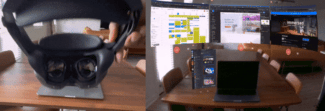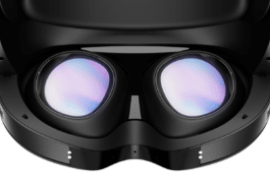A developer posted a short clip showing Quest Pro with peripheral blinders and its color passthrough.
Immersed CEO Renji Bijoy included the clip as a GIF in a blog post. The first few frames show what appears to be Meta’s upcoming Quest Pro, and then transitions to show the headset’s color passthrough. The GIF has since been removed from the original post but has been copied multiple times after its initial posting.
Meta still refers to Quest Pro as Project Cambria – the codename given when it was announced at Connect 2021. Zuckerberg used the name ‘Quest Pro’ in an interview though, and it’s present in the Quest iOS app. It was effectively confirmed earlier this month when a hotel worker found an engineering sample with retail packaging and posted an unboxing video.

That unboxing video showed the headset without a facial interface, meaning you would still see the real world in your peripheral vision. This may be preferable for mixed reality, but would be distracting for virtual reality and detract from immersion. Bijoy’s GIF, however, shows the headset with additional side blinders blocking out peripheral light.
Meta hasn’t yet said whether a facial interface is included with the headset. Notably, the blinders seen here appear to only cover the sides, not below the eyes as in all current VR headsets.

Whereas Quest 2’s view of the real world is a low resolution black & white, Meta revealed Quest Pro has higher resolution cameras with color and a depth sensor to make mixed reality practical. Bijoy’s GIF shows this color passthrough being used to place four virtual monitors beside a MacBook. Given this is a GIF though the quality of the passthrough can’t really be assessed. Last week Mark Zuckerberg showed the passthrough teasing a mixed reality fencing game, but his clip also suffered from heavy video compression.
The new headset looks to have a more balanced design than Quest 2 with a slimmer visor, achieved through the use of pancake lenses instead of fresnel lenses. Pancake lenses are also used in the Pico 4 series – they support smaller panels with a shorter gap to the lenses, and thus a slimmer and lighter visor. Meta also revealed the headset has built-in eye tracking and face tracking to drive avatars in social experiences.
Quest Pro is set to release this month with Meta’s annual AR/VR event on October 11th expected to outline the company’s next steps. Meta revealed it will be priced “significantly” above $800 and sold alongside Quest 2, not replace it.





